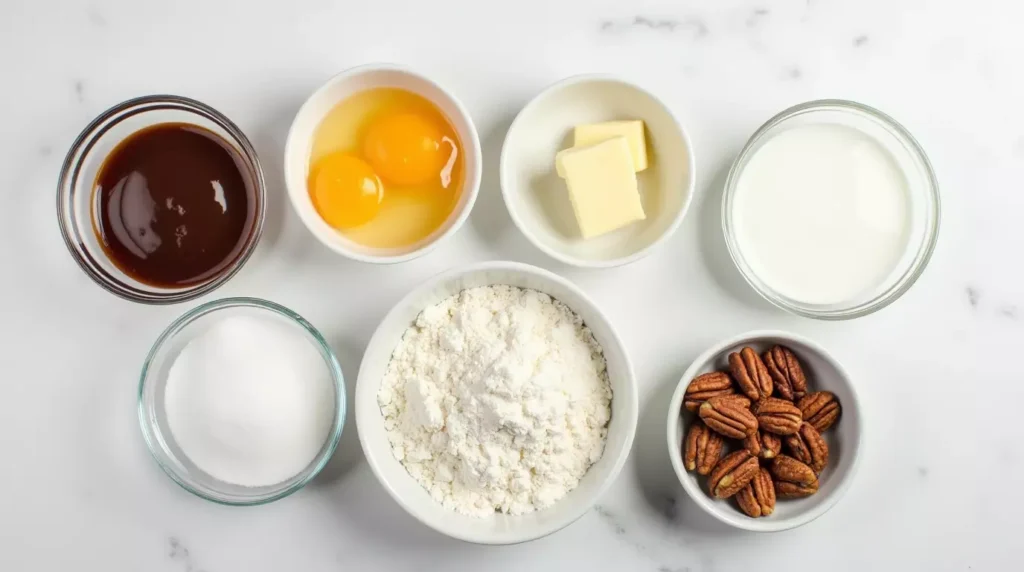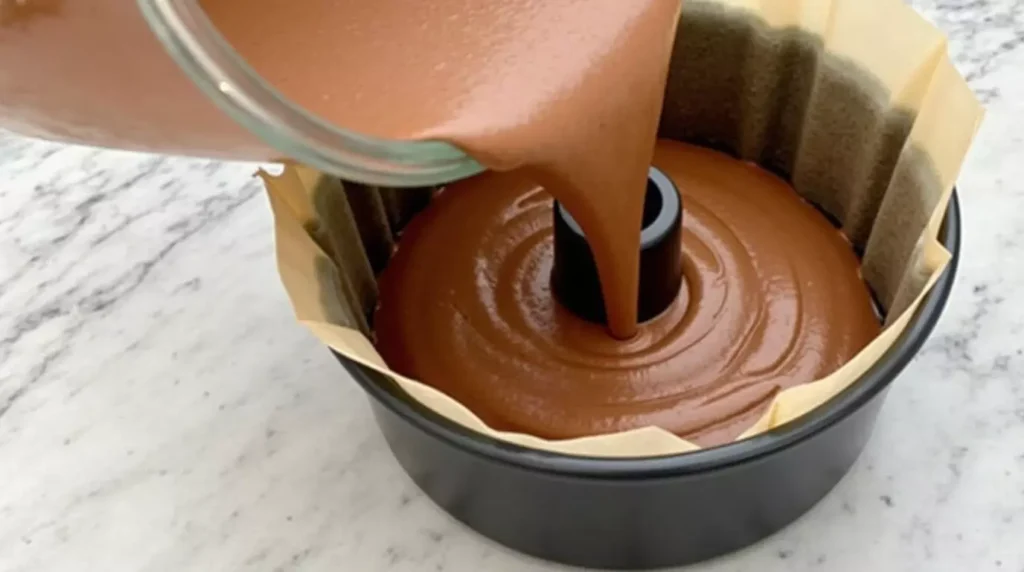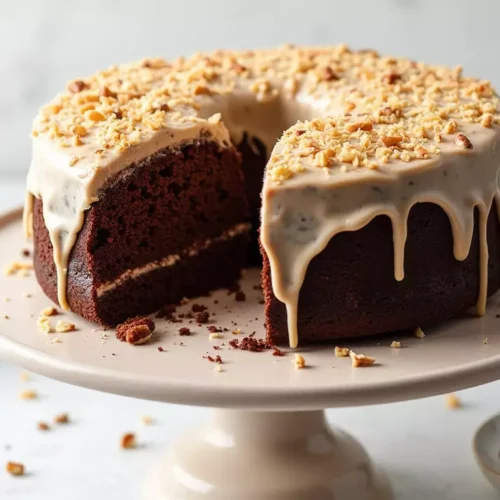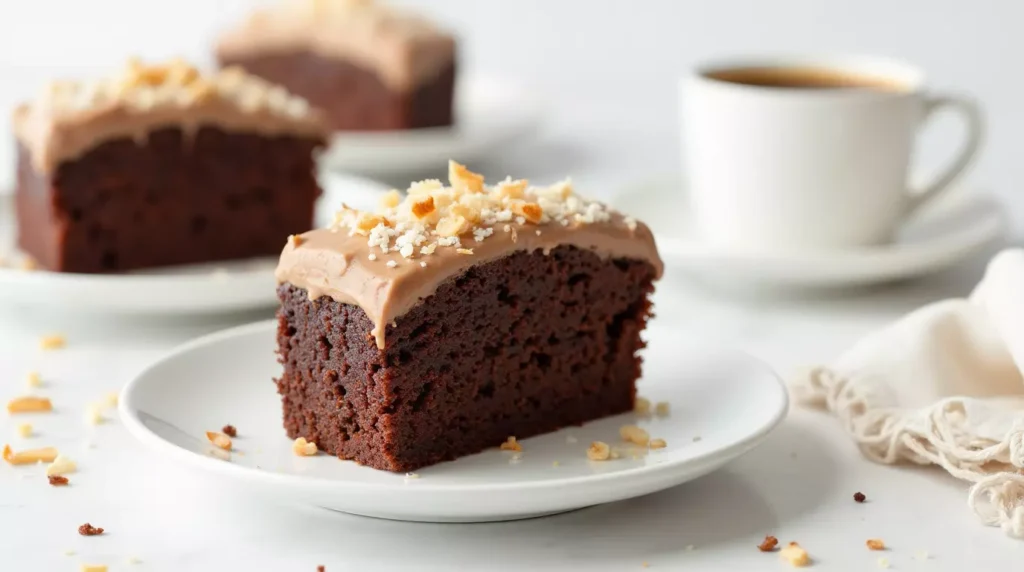There are cakes that whisper.
And then there’s the German Chocolate Pound Cake Recipe, the one that walks in, steals the show, and doesn’t leave until every last crumb disappears.
I still remember my first attempt at making this moist chocolate masterpiece. I thought, “How hard could a rich German chocolate cake really be?”
Spoiler alert: It wasn’t that simple. The cake sank in the middle, the edges were dry, and the frosting, meant to be thick with coconut and pecans, turned into sweet soup.
But that’s the beauty of this classic pound cake. It demands patience, teaches you a few lessons, and when you finally get it right, it’s pure, chocolate-filled joy.
This isn’t a pound cake that politely sits at the dessert table. It’s rich, moist, and unapologetically decadent, topped with a dreamy coconut pecan frosting that makes guests hover around for seconds.
It’s not truly German in origin, despite the name but it’s a showstopper in every kitchen brave enough to bake it.
If you’re ready to create a homemade masterpiece that looks impressive, tastes unforgettable, and proves you don’t need a pastry degree, let’s dive into this perfect German Chocolate Pound Cake Recipe step by step.

What Makes It “German” and Why It’s Not From Germany
You’d think a cake with “German” in the name has some deep connection to Bavaria or a recipe passed down from a village bakery. But the truth is, the only thing German about it is the name of the man who inspired the chocolate.
The Baker Behind the Name
German chocolate pound cake recipe actually gets its name from Samuel German, an American who created a mild dark baking chocolate for Baker’s Chocolate Company in the 1800s. The chocolate was named after him, not his country. Later, someone used it to bake a layered chocolate cake with coconut pecan topping. It took off, and the name stuck. Kind of like how a Taro Smoothie surprises people with its name and delivers way more flavor than expected.
What Sets It Apart from Other Pound Cakes
Most pound cakes are buttery, dense, and lean toward the vanilla or citrus side. This one takes a chocolatey turn without becoming too heavy. The texture stays tender, the flavor is deep and smooth, and it’s bold enough to stand on its own even before the frosting joins the party.

Decadent German Chocolate Explained
The chocolate here is sweet, mellow, and less intense than standard dark chocolate. It balances beautifully with the richness of the pound cake and the sweetness of the topping. Think of it as the bridge between classic cocoa and pure dessert luxury.
It’s not just cake. It’s a dessert that makes people pause mid-bite and say, “Wait, what is this?” That’s the good kind of baking magic.
Building the Perfect Pound Cake Base
You can’t build a skyscraper on a wobbly foundation, and the same rule applies to cake. If the base isn’t right, no frosting or fancy plating is going to save it. Luckily, making a rich and sturdy pound cake isn’t rocket science, just smart baking.
Start with the Right Ingredients
No shortcuts here. You want real butter, the kind that leaves your hands a little greasy just looking at it. Go for unsalted so you can control the flavor. German chocolate is your go-to for that signature taste, and yes, the kind labeled “Baker’s German’s Sweet Chocolate” is the one.
Buttermilk gives the cake a nice tender crumb, while a splash of vanilla rounds everything out. Skip anything that says “light” on the label. This cake is not trying to be skinny.

German Chocolate Pound Cake
Ingredients
Main Ingredients
- 1 cup unsalted butter softened
- 0.5 cup vegetable oil
- 2.5 cups granulated sugar
- 5 eggs large
- 1 tsp vanilla extract
- 0.5 cup sour cream
- 0.5 cup German chocolate melted and cooled
- 3 cups all-purpose flour
- 0.5 tsp baking powder
- 0.5 tsp salt
- 1 cup milk
Instructions
- Preheat oven to 325°F (160°C) and grease a bundt or tube pan.
- Cream butter, oil, and sugar until light and fluffy.
- Beat in eggs one at a time, then add vanilla, sour cream, and melted chocolate.
- In a separate bowl, whisk flour, baking powder, and salt.
- Add dry ingredients to the wet mixture alternately with milk, mixing until smooth.
- Pour batter into pan and bake for 70–80 minutes or until a toothpick comes out clean. Cool before serving.
Notes
Why Your Eggs and Sugar Matter
Eggs bring the structure, sugar brings the moisture and the crusty edges that make each slice feel special. Use large eggs at room temperature. Cold eggs don’t play nice when mixing.
And don’t rush the creaming process. When you beat butter and sugar until fluffy, that’s where a lot of your cake’s lift comes from. Think of it as building tiny air pockets that help everything bake evenly.
The Secret to That Dense but Tender Texture
A good pound cake feels substantial without being heavy. The trick is to balance moisture and density so the cake is rich, but still has a soft bite.
This happens when your flour is measured right, your ingredients are at room temp, and you don’t overmix once the flour goes in. A few stirs too many, and you’ve got a gummy center no one wants to eat.
This is the moment to be gentle. Let the ingredients work together without bullying them into submission.

The Coconut-Pecan Frosting Everyone Fights For
This frosting is the main reason people hover around the cake table. It’s sticky, sweet, nutty, and just gooey enough to feel like a dessert on its own. If the cake is the star, the frosting is the scene-stealer.
Toasted Coconut or Straight from the Bag?
Toasting your coconut makes a huge difference. It brings out a warm, nutty flavor that plain coconut just doesn’t have. You can skip this step if you’re in a hurry, but if you’ve got ten extra minutes, it’s worth the upgrade.
Pecans can also be toasted if you’re feeling fancy. Just keep an eye on them because they go from golden to burnt in seconds.
Getting the Consistency Just Right
This frosting shouldn’t drip or run. It should be thick enough to spread and hold its shape, but still soft and glossy. That sweet spot comes from gentle simmering and constant stirring.
Egg yolks, evaporated milk, and butter form the base. Stir in the sugar and keep the heat low. You want it to thicken slowly, not curdle. Once it coats the back of a spoon, it’s time for the coconut and pecans to join the party. Love rich, spiced toppings? Try a drizzle of Gingerbread Honey next time for a warm twist on any baked treat.
To Frost the Whole Cake or Just the Top
Traditionally, German chocolate cakes are layered with frosting between each tier and right on top. Pound cake doesn’t need all that. A thick layer across the top and a little drizzle down the sides is all it takes.
Want to be extra? Let it chill slightly, then dollop a bit on each slice as you serve. It feels like a bakery move, but it’s super easy to do.

Bake It Like You Mean It
At this point, your batter is looking smooth, your kitchen smells like sweet success, and you’re ready to bake. But don’t let all that prep go to waste with a half-hearted bake. Pound cake needs the right setup to come out just right.
Getting the Bake Time Right
German chocolate pound cake takes time. You’re looking at around an hour or more, depending on your oven and pan. Low and slow is better than rushing with high heat. You want the cake to cook evenly from edge to center without overbaking the top.
Don’t crank the oven up thinking you’ll shave off a few minutes. You’ll just get a burned crust and a raw middle.
How to Avoid a Dry Pound Cake
Dry cake usually means one of two things. Either you baked it too long, or you didn’t have enough fat in the mix. If you followed the recipe and your ingredients were solid, the oven is your next suspect.
Use an oven thermometer to check that your temp is accurate. Many ovens run hotter than they say. And don’t keep opening the door to check. Every time you peek, the temperature drops.
Oven Racks, Pan Types, and Your Best Tools
Stick with the middle rack. It’s the sweet spot for even heat. As for pans, a classic bundt or loaf pan with a light interior works best. Dark pans cook faster and can dry out the edges.
Grease your pan well. Then flour it or line it, depending on the design. You want the cake to release smoothly without breaking apart.
The Toothpick Test Is Not Enough
That toothpick method? It’s only part of the story. You want to see a clean pick, yes, but also listen. A fully baked cake will have pulled slightly from the edges and feel springy when lightly pressed on top.
If the top jiggles when you touch it, it’s not ready. Give it a few more minutes and check again.
Serving, Storing, and Showing Off
Once your German chocolate pound cake is baked and frosted, it’s time to enjoy the reward. Whether you’re slicing it for guests or sneaking a piece after dinner, this cake is built to impress.
How to Dress It Up
The cake already looks like a showstopper, but a little extra goes a long way. Add a swirl of whipped cream, a handful of toasted coconut, or a light dusting of powdered sugar. If you’re feeling playful, drizzle some chocolate sauce around the plate. Simple touches can make a slice look like it came from a fancy bakery.
What to Serve With It
This is a rich dessert, so pair it with something simple. Vanilla ice cream or a scoop of coconut sorbet adds a cooling contrast. Fresh berries help balance the sweetness. A cup of hot coffee or even a glass of cold milk works perfectly. Or if you’re after something cold and fruity, this Mango Pineapple Strawberry Smoothie makes a bright, refreshing pairing.
This cake can play both casual and formal. It’s just as good on a dinner party platter as it is with your weekend coffee.
Best Ways to Store (and Reheat If You Must)
Let the cake cool completely before storing. Wrap it tightly or place it in an airtight container to keep the frosting and crumb in top shape. It stays fresh at room temperature for a couple of days. After that, move it to the fridge.
To reheat, warm individual slices in the oven wrapped in foil. This brings back the softness without drying it out. Skip the microwave unless you’re in a serious hurry, because it can make the texture uneven.
Leftovers freeze well too. Wrap slices individually, then store them in a freezer bag. Future-you will be very happy.
FAQs – German Chocolate Pound Cake Recipe
What makes German chocolate pound cake different?
A German chocolate pound cake stands out because of its rich chocolate flavor and moist, dense texture. It’s paired with a sweet coconut pecan frosting, giving it that signature layered taste in every bite. It’s not your average pound cake it’s deeper, sweeter, and a little more indulgent.
Is German chocolate actually from Germany?
No, German chocolate isn’t from Germany. It’s named after Samuel German, an American who developed a type of sweet baking chocolate. So, despite the name, German pound cake is a proudly American creation.
Can I make this cake without the frosting?
You can, but the decadent German chocolate experience is really about the full combo. That coconut pecan frosting is part of what makes this cake memorable. If you skip it, you still get a delicious chocolate pound cake, but it might feel like something’s missing.
How should I store German chocolate pound cake?
Wrap the cake tightly or store it in an airtight container at room temperature for up to two days. After that, place it in the fridge to keep the frosting fresh. You can also freeze individual slices for easy grab-and-go treats.
Final Thoughts
Making a German chocolate pound cake from scratch isn’t just about following a recipe. It’s about diving into something rich, slightly nostalgic, and totally satisfying. Sure, it takes a bit of effort, but every step pays off when you slice into that moist cake and the frosting gets just a little messy in the best way.
It’s not a complicated cake, but it is a bold one. The kind of dessert that feels homemade in the best sense. It brings people to the table and keeps them there for just one more bite.
So go ahead. Whip out the good chocolate, toast your coconut, and make a cake that actually feels like something special. This one’s worth it. And if you’re planning the full dinner spread, something like Lemon Pepper Trout makes a zesty, savory main course before dessert.


Where did you get that parchment paper from for the bundt pan?
I stumbled on it by chance on Amazon and I’m so glad I did! It works amazingly well and makes baking with a bundt pan so much easier!
Mmm, that looks yummyyy
OMG, this cake is pure chocolate bliss! I need a slice (or two) ASAP. Thanks for sharing this deliciousness!